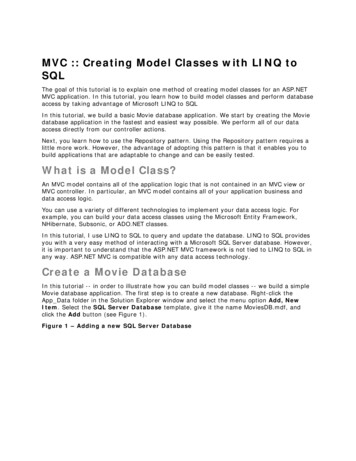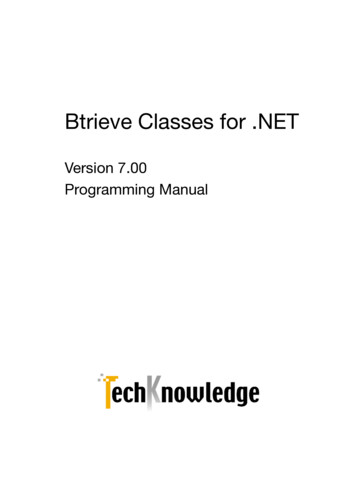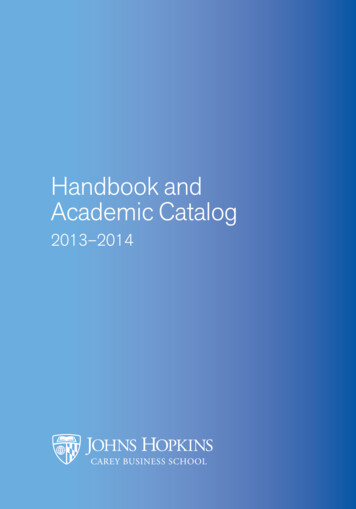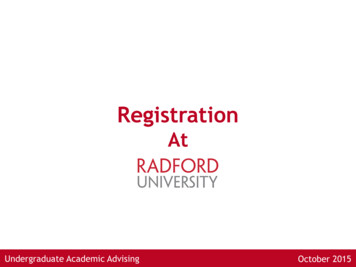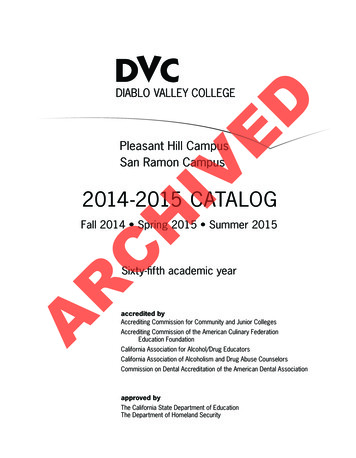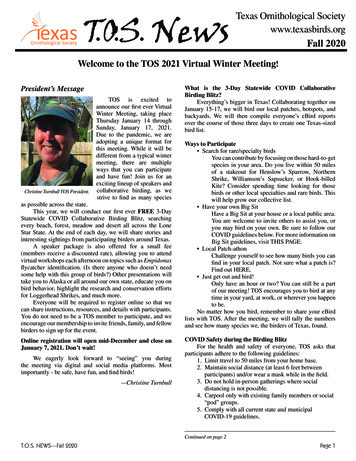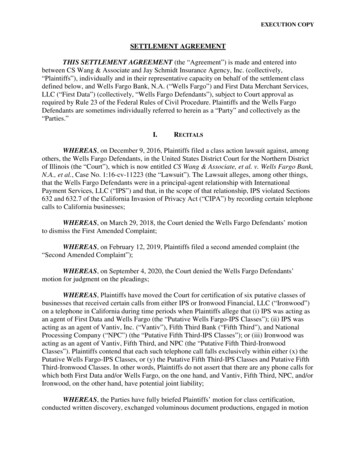
Transcription
Database Systems Journal vol. V, no. 1/20143New Classes of Applications in the Cloud.Evaluating Advantages and Disadvantages of Cloud Computing forTelemetry ApplicationsAnca APOSTU, Florina PUICAN, Geanina ULARU,George SUCIU, Gyorgy TODORAN1, 2, 3University of Economic Studies, Bucharest, Romania4, 5University Politehnica of Bucharest, Romaniaancaiapostu@gmail.com, puicanflorina@yahoo.com, ularugeanina@yahoo.com,george@beia.ro, todoran.gyorgy@gmail.comNowadays companies are moving some parts of their businesses to the cloud. Industrypredictions are that this trend will continue to grow and develop even further in the comingfew years. While Cloud computing is undoubtedly beneficial for mid-size to large companies,it is not without its downsides, especially for smaller businesses. This paper‘s aim is to deliveran analysis based on advantages and disadvantages of Cloud computing technology, in orderto help organizations fully understand and adopt this new computing technology. Finally, toprove the advantages that Cloud technology can have for this domain, we are presenting acloud application for telemetry, with a focus on monitoring hydro-energy. We consider thatthe way to attain the benefits of Cloud technology is to understand its strengths andweaknesses and adapt to them accordingly.Keywords: Advantages, Architecture, Cloud Computing, Grid Computing, Telemetry1IntroductionNowadays evolution has its premiseson the fact that faster access to innovationdrives higher productivity. The Web isrecognized as epicenter of innovation.Rapid innovation powered by the Cloudhas an advantage over traditionaltechnology cycles: employees adapt to acontinuousstreamofmanageableimprovements better than they toleratelarge, disruptive batches of change.Gradual iterations in bite-sized chunkssubstantially reduce change-managementchallenges. Conversely, employees aresubjected to a painful re-learning cycleeach time companies upgrade traditionalsoftware.2. Cloud computing - actual contextBecause data is stored in the Cloud insteadof on employee computers, Cloudcomputing enhances multiple users toaccess and contribute to projectssimultaneously without worrying aboutusing the same operating system, software,or browser. For example, instead ofcollaborating on a document by sendingback and forth revision after revision asattachments, documents are stored in thecloud. Co-workers can access the webbased document simultaneously in theirbrowsers, and even make changes thatother authorized users can see in real-time.Eliminating attachment round-trips bystoring data in the cloud saves time andreduces frustrations for teams who need towork together efficiently.Through synchronous replication, data anduser actions are mirrored in nearly realtime across multiple data centers. If onedata center becomes unavailable for anyreason, the system is designed to instantlyfall back to a secondary data center with nouser-visible interruption in service.Cloud provides extensive flexibility andcontrol. Nevertheless, moving to the clouddoesn't mean that businesses lose controlof their data or their technology. Forexample, the Google Apps Terms ofService explicitly state that customersretain ownership of their data in GoogleApps.Furthermore, cloud providers give controlsso administrators can manage which
4New Classes of Applications in the Cloud.Evaluating Advantages and Disadvantages of Cloud Computing for Telemetry Applicationsapplications their users can access and howemployees can use each service. They alsoallow administratorsbuildcustomfunctionality and integrations with othertechnologies.Going detailed in the topic of CloudComputing we must mention that CloudComputing is split in three differentcategories according to [1]:1. IaaS - Infrastructure as a Service:Virtual provision of computingpower and/or memory. Source [2]mentions as prominent example of anIaaS service the Amazon WS service.2. PaaS – Platform as a Service:Provision of a runtime environment,like application servers, databases. Inthis area, paper [2] providesGoogle’s App Engine as probablythe most prominent example.3. SaaS – Software as a Service:Provision of usually browser basedapplications that can directly be used.Google Docs or the CustomerRelationship Management softwareof salesforce.com might serve asexamples.3. Evolution is shown by newachievements - distributed computingversus grid computingCloud evolved from Grid computing, butthe latter can function separately. Clouddefinition usually superposes with Gridcomputing technology or more generallywith distributed computing definition.From the end user perspective, the interestin what actually happens “behind thescenes” in Cloud is minimum, incomparison with system administratorswho virtualize servers and handleapplications in cloud. Grid Computing isthe infrastructure on which cloudcomputing relies.There are differences and similaritiesbetween the two mentioned technologies.Cloud and grid computing assurescalability, they are multitasking and shareresources among a large number of endusers. The differences come by analyzingthe computing model, data management,the visualization or security model. GridComputing “enables resource sharing andcoordinated problem solving in dynamic,virtual organizations” [3]. From computingmodel perspective, grid computing usesbatch computation and via batches thereare identified users and the number ofprocessors required, whereas Cloudcomputing functions with resources sharedby users in the same time.Data management structure is veryimportanttoprovidemanagementimplementation to the needed data and alsofast and efficient data retrieval. Gridcomputing is using data ware schedulers[4], but Cloud might be challenged by thedata handling from applications, withoutinvesting in the data access patters.Virtualization and encapsulation are veryused in cloud and more intensively in gridcomputing, because the grid holds thecontrol on the resources, withoutnecessarily virtualizing them.From the security model perspective, theremight be a potential issue in cloud. Fordata protection, the users might desire tomanage their own private keys, but for this,detailed private key management should beprovided. Nevertheless, from Gridcomputing perspective resources areheterogeneous and have their autonomy.The security in Grid computing is assuredin the infrastructure.Our comparison between the twotechnologies puts in spot light the commonshare of visions and architectures, but alsothe differences between them at the datamanagement and security model. We haveidentified the weaknesses that should beovercome by both technologies in order tospeed up their evolution.4. Analysis of advantages anddisadvantages of cloud computingIn the following section we are presentingthe main advantages and disadvantages ofCloud Computing applying them fortelemetry applications.
Database Systems Journal vol. V, no. 1/2014A. Advantages of Cloud ComputingSpeaking about advantages of CloudComputing we present bellow the mainbenefits for businesses in general, focusingat some points on examples for smallbusinesses: Cost efficiency - Cloud computing isprobably the most cost efficientmethod to use, maintain and upgrade,as explained in [5]. Traditional desktopsoftware costs companies a lot, interms of finance. Adding up thelicensing fees for multiple users canprove to be very expensive for theestablishment concerned. The cloud, onthe other hand, is available at muchcheaper rates and hence, cansignificantly lower the company’s ITexpenses. Besides, there are many onetime-payments, pay-as-you-go andother scalable options available, whichmake it very reasonable for thecompany in question. Paper [6] adds upthat it lowers the cost for smaller firmswhich intend to apply the computeintensive techniques. Almost Unlimited Storage. Storinginformation in the cloud gives youalmost unlimited storage capacity. Backup and Recovery. Since all thedata is stored in the cloud, backing itup and restoring the same is relativelymuch easier than storing the same on aphysical device. Furthermore, mostcloud service providers are usuallycompetent enough to handle recoveryof information. Hence, this makes theentire process of backup and recoverymuch simpler than other traditionalmethods of data storage. Automatic Software Integration. In thecloud, software integration is usuallysomething that occurs automatically.This means that Cloud users don’t needto take additional efforts to customizeand integrate their applications as perown preferences. This aspect usuallytakes care of itself. Easy Access to Information. Once theusers register in the cloud, they can5 access the information from anywhere,where there is an Internet connection.This convenient feature lets users movebeyond time zone and geographiclocation issues.Quick Deployment. Lastly and mostimportantly, Cloud computing givesthe advantage of quick deployment.Once opting for this method offunctioning, the entire system can befully functional in a matter of a fewminutes. Of course, the amount of timetaken here will depend on the exactkind of technology that is needed forthe business.Easier scale of services. It makes iteasier for enterprises to scale theirservice according to the demand ofclients.Deliver new services. It makes possiblenew classes of applications anddeliveries of new services that areinteractive in nature.B. Performance achievement with CloudTechnologies and Parallel ComputingAmong the benefits of Cloud Computingthere can be mentioned the accessibility tocustomized virtual machines, the paymentdone for what it is used and efficientresource allocation. Cloud computingbrings advantages not only to largecompanies, but also to small and mediumsized ones, by outsourcing datainfrastructure. The data can be accessedfrom any location, from the clouds.Better performance is achieved in thecontext of parallel computing with Cloudtechnologies. Applications that encounterlatencies can overcome their deficienciesby utilizing technologies such as ApacheHadoop (a study on Apache Hadoop ispresented in paper [7]), MapReduce(former CGL-MapReduce) and Dryad.Nevertheless, more complex applications,with higher expectations from theperformance point of view, requirecommunication paradigms and customizednetwork settings such as MPI (Message
6New Classes of Applications in the Cloud.Evaluating Advantages and Disadvantages of Cloud Computing for Telemetry ApplicationsPassing Interface), a standardized API usedto implement parallel applications.The MPI implications for virtualizedresources might be analyzed through itsimplementation.Theanalysisofperformance achievement implies theunderstanding of the complex process ofthe application's adoption of MPI and itsimpact on cloud resources. MPI sustainsI/O operations, collective communicationand point-to-point communication [6]. Theimprovements of MPI on the applicationreflect the mapping of the processors fromthe clusters. The CPUs evaluation mightprovide indicators regarding this aspect.From the performance point of view wepropose a comparison for differentcharacteristics of the parallel computingtechnologies. From the programminglanguages perspective, for MPI, there areused C , Java and C#, for Dryad thereare C# and DryadLINQ, for MapReduceand Hadoop the main used language isJava. The data usage is assured by MPI,Dryad and MapReduce through directories,shared files and local disks and for Hadoopby HDFS. The communication is achievedin MapReduce by distribution network, inHadoop by HDFS, in MPI and Dryad byfiles and TCP pipes. The failures areworked on differently according to whattechnology is used; for MPI there isOpenMPI and for Dryad the failure ishandled by the re-execution of maps.Cloud technologies enhance the way BigData is handled and the processes used forfailures approaches. The minuses might beconsidered when the computation is movedto data and the parallel computing is doneon the local storage.C. Disadvantages of Cloud ComputingIn spite of its many benefits, as mentionedabove, Cloud computing also has itsdisadvantages. Businesses, especiallysmaller ones, need to be aware of theseaspects before going in for this technology.The main risks involved in CloudComputing are: Technical Issues. Though it is true thatinformation and data on the Cloud canbe accessed any time and fromanywhere, there are moments when thesystem can have some seriousmalfunction. Businesses should beaware of the fact that this technology isalways prone to outages and othertechnical issues. Even the best Cloudservice providers run into this kind oftrouble, in spite of keeping up highstandards of maintenance.Security in the Cloud. The other majorissue of Cloud is represented bysecurity.Beforeadoptingthistechnology, beneficiaries should knowthat they will be surrendering all theircompany’s sensitive information to athird-party cloud service provider. Thiscould potentially impose a great risk tothe company. Hence, businesses needto make sure that they choose the mostreliable service provider, who will keeptheir information totally secure.“Switching to the cloud can actuallyimprove security for a small business”,as mentioned by Michael Redding,managing director of AccentureTechnology Labs, cited by [8].“Because large cloud computingcompanies have more resources, hesays, they are often able to offer levelsof security an average small businessmay not be able to afford implementingon its own servers” [8].Prone to attack. Storing information inthe cloud could make the companiesvulnerable to external hack attacks andthreats; therefore there is always thelurking possibility of stealth ofsensitive data.Possible downtime. Cloud computingmakes the small business dependent onthe reliability of their Internetconnection.Cost. At first glance, a cloudcomputing application may appear tobe a lot cheaper than a particularsoftware solution installed and run inhouse. Still, the companies need to
Database Systems Journal vol. V, no. 1/2014ensure that the cloud applications haveall the features that the software doesand if not, to identify which are themissing features important to them. Atotal cost comparison is also required.While many cloud computer vendorspresent themselves as utility-basedproviders, claiming that they onlycharge for what customers use, Gartnersays that this isn't true; in most cases, acompany mustcommittoapredetermined contract independent ofactual use. Companies need to lookclosely at the pricing plans and detailsfor each application.Furthermore, “the increase of thedemand for computing resources hasled to the deployment of cloudcomputing data centers and to acorresponding and significant increaseof the total energy consumed by theseinfrastructures”, as paper [9] explains. Inflexibility. Choosing a Cloudcomputing vendor often means lockingthe business into using their proprietaryapplications or formats. For instance, itis not possible to insert a documentcreated in another application into aGoogle Docs spreadsheet. Furthermore,a company needs to be able to addand/or subtract Cloud computing usersas necessary as its business grows orcontracts. Lack of support. Anita Campbell(OPEN Forum) writes, “Customerservice for Web apps leaves a lot to bedesired - all too many cloud-basedapplications make it difficult to getcustomer service promptly – or at all.Sending an email and hoping for aresponse within 48 hours is not anacceptable way for most of us to run abusiness” [10]. The New York Timeswrites: “The bottom line: If you needhandholding or if you are notcomfortable trying to find advice onuser forums, the cloud probably is notideal” [11].Paper [12] adds up “some of the majortechnical risks, which include: multi-tenant7environment; internet as connection;system complexity and loss of control.”Also “new vulnerabilities inherent toCloud computing include breaches fromone virtual computing space to another,misappropriation of session security fromweb protocols, and limited encryptioncapabilities in many protocols.”As paper [13] explains about adoption ofCloud computing, “it doesn't mean thatevery small business should immediatelythrow out all their servers and software andconduct all their business operations in thecloud”. Small business owners havedifferent needs and different comfort levels.It may be more advantageous for you touse cloud computing only for certainapplications. Or even not at all. Previouslyto adopting Cloud computing, businessowners should consider how thesedisadvantages of cloud computing couldaffect their small business.A very interesting comparative study basedon cloud Computing is presented in paper[14] following a series of surveysconducted in Australia and Czech Republicat the end of 2011. The aim of this studywas “to identify differences betweenadoption patterns in countries withdifferent level of readiness for Cloudcomputing”. An interesting result of thisresearch relates to changes in perception ofadoption issues following a decision toadopt cloud services. The results indicatethat “concerns about data security, ITgovernance, service availability anddependence on service provider are held bymuch lower number of respondentsfollowing adoption of cloud services”.Finally, the study indicates that “SaaSadoption is confined to a small number ofrelatively simple types of enterpriseapplications that include CRM, email andother types of collaboration software”.One can only say that Cloud computing isa complex and rapidly evolving concept,therefore companies should consider someimportant aspects when planning theirinitiative towards adopting this technology:
8New Classes of Applications in the Cloud.Evaluating Advantages and Disadvantages of Cloud Computing for Telemetry Applications Understand what Cloud computingtechnology is, how it will evolveand under what circumstances itcan offer value; Evaluate models, architectures,technologies and IT organizationbest practices which are suitable forthe companies which want to adoptCloud computing in order to buildprivatecloudcomputingenvironments. Consider how IT will secure,manage and govern cloud servicesacross public, community, privateand hybrid environments. Determine the which possibilitiesare for migrating applications to thecloud and if this brings value to thecompany and also determineopportunities to create “new cloudoptimized applications”[15]. Analyze the way in which Cloudcomputing will affect the strategyand direction of IT and identify theopportunities for the enterprise to“providecloudservicestocustomers or partners”.D. Cloud Advantages for TelemetryApplicationsAfter analyzing the advantages anddisadvantages of Cloud, in this chapter wepresent a Cloud test platform for cleanenergy production telemetry, with focus onhydro-energy. We use different types ofRTU’s (Remote Telemetry Units) andsensors that monitor and transmitimportant information from selectedlocations such as temperature, precipitation,water level in the dam, quantity of watercaptured during winter or summer.The RTUs transmit sensor data overGSM/GPRS to our cloud platform wherewe can conveniently process the sitespecific data in near real-time, display it inour web-based visualization applicationand get detailed recommendations whenand where to generate energy - resulting inoptimized energy production and income.Our system can be connected with othermanagement systems to make better use ofresources keeping in view other factorslike energy price, consumption trends andto improve risk management [16].Variable prices and rising costs ofproduction are forcing energy producers tooptimize production costs. Therefore"precision energy production", theoptimized use of natural energy resourcessuch as water, sun or wind is nowindispensable. The growing environmentalawareness of consumers further acceleratesthis process and promotes the usage ofremote automatic monitoring system forfield information such as the one wedeveloped.We will introduce SlapOS [17], the firstopen source operating system forDistributed Cloud Computing. SlapOS isbased on a grid computing daemon calledslapgrid which is capable of installing anysoftware on a PC and instantiate anynumber of processes of potentially infiniteduration of any installed software. Slapgriddaemon receives requests from a centralscheduler the SlapOS Master whichcollects back accounting information fromeach process.SlapOS[17] is an open source CloudOperating system which was inspired byrecent research in Grid Computing and inparticular by Bonjour Grid [18], a metaDesktop Grid middleware for thecoordination of multiple instances ofDesktop Grid middleware. It is based onthe motto that ”everything is a process”.SlapOS Master follows an EnterpriseResource Planning (ERP) model to handleat the same time process allocationoptimization and billing. SLAP stands for“Simple Language for Accounting andProvisioning”.This structure has been implemented forcloud-based automation of ERP and CRMsoftware for small businesses and aspectsare under development under theframework of the European researchproject “Cloud Consulting”. We will useour platform hosted on several servers
Database Systems Journal vol. V, no. 1/20149running Ubuntu Linux – Apache – MySQLtemplate with current software release.On our cloud testing environment weprovide the platform for processinginformation from hundreds differentsensors, enabling the analysis ofenvironmental data through a large sampleof RTUs. In previous approaches RTUswere implemented in most cases on a localserver and no company could aggregateenough sensor data to consider automatingthe production process and providing therequired resilience [19].E. Cloud Telemetry ComponentsTelemetry systems have a large area ofusage, as presented for example in paper[20], for “rain rate measurements” or for“distributed wells” in paper [21].1) Cloud ArchitectureSlapOS is based on a Master and Slavedesign. Slave nodes request to Masternodes which software they should install,which software they show run and reportto Master node how much resources eachrunning software has been using for acertain period of time. Master nodes keeptrack of available slave node capacity andavailable software. Master node also actsas a Web portal and Web service so thatend users and software bots can requestsoftware instances which are instantiatedand run on Slave nodes.ClientMasterSlaveSlaveMobile DeviceOfficeSlaveHomeSlaveDataCenterFig. 1 SlapOS Master – Slave Cloud ArchitectureMaster nodes are stateful. Slave nodes arestateless. More precisely, all informationrequired to rebuild a Slave node is storedin the Master node. This may include theURL of a backup service which keeps anonline copy of data so that in case offailure of a Slave node, a replacementSlave node can be rebuilt with the samedata.It is thus very important to make sure thatthe state data present in Master node iswell protected. This could be implementedby hosting Master node on a trusted IaaSinfrastructure with redundant resource. Or- better - by hosting multiple Master nodeson many Slave nodes located in differentregions of the world thanks to appropriatedata redundancy heuristic. We are touchinghere the first reflexive nature of SlapOS. ASlapOS master is normally a runninginstance of SlapOS Master softwareinstantiated on a collection of Slave nodeswhich, together, form a trusted hostinginfrastructure. In other terms, SlapOS isself-hosted.SlapOS Slave nodes are relatively simplecompared to the Master node. Every slavenode needs to run software requested bythe Master node. It is thus on the Slavenodes that software is installed. To savedisk space, Slave nodes only install thesoftware which they really need.
10New Classes of Applications in the Cloud.Evaluating Advantages and Disadvantages of Cloud Computing for Telemetry ApplicationsEach slave node is divided into a certainnumber of so-called computer partitions.One may view a computer partition as alightweight secure container, based onUnix users and directories rather than onvirtualization. A typical bare-bone PC caneasily provide 100 computer partitions andcan thus run 100 RTU web portals or 100sensors monitoring sites, each of whichwith its own independent database. Alarger server can contain 200 to 500computer partitions.monitored installation site is mounted aninstallation built mainly from distant RTU,sensors and actuators. There will be usedespecially RTUs capable to communicatewith the Gateway through GSM-GPRS andInternet. For the installation sites which aresituated in no GSM coverage areas will beused RTUs in the UHF band of 430-440MHz. These will communicate with thedate concentrator through a bridge station(bridge) which will ensure the UHF-GPRSand GPRS-UHF conversion. In therelatively few instances when this will bepossible,theRTU-Gatewaycommunication will be held radioexclusively in the UHF band of 430-440MHz.2) Telemetry ArchitectureIn Fig. 1 we present the general structureof the system that we are proposing for thetele-monitoring of installation sites inhydro power stations. At each of theGatewayApplicationServerGSM - GPRSInternetRTUPresentationServerSensors andActuatorsUserUserFig. 2 General structure of the tele-monitoring systemThe key elements of the system are: Gateway,whichensuresthecommunication with the RTUs andavailable resource management; Presentation Server (PS) which ishosted on a computer with serverfeatures (for example, unattendedoperation 24/24), equipped with asoftware packet focused mainly on datapresentation in various forms, entirelyavailable to users. Application Server (AS), focused onspecial tasks, which PS can’t perform.Practically, all system communication isdone through Internet and this gives thesystem investment and mostly operationaladvantages. It is mentioned that the userscan access the processed data, offered bythe PS and AS anywhere and anytime,from any terminal with Internet access (PC,tablet, mobile phone etc.). The system’scentral elements are configured and scaledso that they would allow a system takeoverof 100 RTUs
Database Systems Journal vol. V, no. 1/20145. ConclusionsWe conclude that while Cloud computingtechnology can prove to be a great asset tocompanies, it could also cause harm if notunderstood and used properly.We consider Cloud computing to be anopportunity for small businesses to balancethe efforts implied by IT management ofcourse limited by the disadvantages ofCloud, some of them presented in thispaper. The first and most importantconcern is given by security issues relatedto having their business data in the Cloudor, in a simpler way, having their data outon the Internet. Nevertheless, therecommendation would be to beginadopting Cloud Computing for a smallerpart of their business applications in orderto be able to count down the benefits andalso to identify the risks.6. Future researches“Companies that are dependent on the ITenvironment of today need to remaincompetitive and, in order to do this, theyneed to keep up with the most recenttechnologies such as Cloud computing,mobile devices and virtualization” [22]. Asidentified by Gartner’s Symposium/ITxpoin Orlando 2012 [15], Personal Cloud,Hybrid IT & Cloud Computing and BigData will be between the most importantten strategic technology trends for 2013.Except for the much debated advantages ofCloud Computing these three trendsrepresent major Cloud advances in thefuture and these will be subject for ourfuture research.References[1] Chappell, D., A short introduction tocloud platforms: An enterpriseoriented view, White Paper, 13 pages,SanFrancisco,ChappellandAssociates, 2008[2] Marc Jansen, What does it servicemanagement look like in the Cloud?An ITIL based approach, Proceedingsof the International Conference onComputers, Digital Communications11andComputing(ICDCC'11),Barcelona, Spain, September 15-17,2011, pp. 87-92, ISBN: 978-1-61804030-5[3] I. Foster, C. Kesselman, J. Nick, S.Tuecke, The Physiology of the Grid:An Open Grid Services Architecturefor Distributed Systems Integration.Globus Project, 2002.[4] I. Raicu, Y. Zhao, I. Foster, A. Szalay.AcceleratingLargescaleDataExploration through Data Diffusion,International Workshop on DataAware Distributed Computing, 2008.[5] P. Viswanathan, Cloud Computing – Isit Really All That Beneficial?Advantages and Disadvantages ofCloud at-Beneficial.htm[6] C. Evangelinos, C. Hill., CloudComputing for parallel Scientific HPCApplications: Feasibility of RunningCoupled Atmosphere-Ocean ClimateModels on Amazon's EC2, The FirstWorkshop on Cloud Computing and itsApplications (CCA’08), 2008, Chicago[7] E. G. Ularu, F. C. Puican, A. Apostu,M. Velicanu, Perspectives on Big Dataand Big Data Analytics, DatabaseSystems Journal vol. III, no. 4/2012,pp.3-14, ISSN: 2069 – 3230[8] O. EL Akkad, Outsource IT Headachesto the Cloud, The Globe and Mail, 11November 2010.[9] J. Rietz, R. Macedo, C. Alves, J. V. DeCarvalho, Efficient Lower BoundingProcedures with Application in theAllocation of Virtual Machines to DataCenters, WSEAS Transactions onInformation Science & Applications,Volume 8, 2011, Print ISSN: 17900832, E-ISSN: ransactions/information/2011/53-343.pdf[10] A. Campbell, These Issues Need tobeResolvedBeforeCloud
12[11][12][13][14][15][16][17]New Classes of Applications in the Cloud.Evaluating Advantages and Disadvantages of Cloud Computing for Telemetry ApplicationsComputing Becomes Ubiquitous, 11August esubiquitous-1/D. H. Freedman, Thinking aboutmoving to the Cloud? There aretrade-offs, 21 September 2011, TheNew York TimesJ.L. Kourik, For Small and MediumSize Enterprises (SME) DeliberatingCloud Computing: A ProposedApproach, Proceedings of theEuropean Computing Conference(ECC ’11) Paris, France, April 2830, 2011,
A. Advantages of Cloud Computing Speaking about advantages of Cloud Computing we present bellow the main benefits for businesses in general, focusing at some points on examples for small businesses: Cost efficiency - Cloud computing is probably the most cost efficient method to use, maintain and upgrade, as explained in [5].

